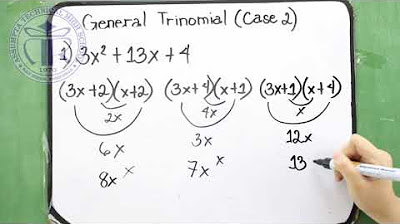❖ Factoring Trinomials (A quadratic Trinomial) by Trial and Error ❖
Summary
TLDRThis video explains how to factor quadratic trinomials using the trial-and-error method. Despite its simplicity, this method can be tedious and requires testing multiple combinations of numbers. The speaker walks through factoring a quadratic expression (3x² + x - 4), demonstrating how to create two sets of parentheses, and how different factor combinations either work or fail. Emphasizing patience and practice, the speaker acknowledges that factoring can be time-consuming and frustrating, but it's a skill that improves with experience. The key takeaway is persistence and practice in solving such problems.
Takeaways
- 🔢 Factoring trinomials by trial and error can be tedious, even with seemingly simple problems.
- 🧮 The process involves trying different combinations of factors to find a factorization that works.
- 🔄 Multiple sets of factors must be tested, as flipping the order of factors can change the result.
- ❌ If a particular combination doesn't work, it doesn't mean the expression can't be factored—it may just not factor with rational numbers.
- 🧩 The key challenge is finding numbers that multiply to the constant term and fit the middle term.
- ⚖️ Trial and error often involve testing different combinations of signs and factor orders.
- 🤔 Factoring becomes more complex when the leading coefficient has multiple factors, increasing the number of possibilities.
- ⏳ The process can take time, especially if the factors don't align quickly, leading to frustration for students.
- 💡 Despite the difficulty, practice is essential to mastering this technique and becoming faster at it.
- 📚 The video emphasizes persistence and patience, as even experienced individuals may find these problems tedious.
Q & A
What is the main topic discussed in the video?
-The video discusses factoring trinomials by trial and error, focusing on factoring a quadratic expression.
Why does the speaker describe the factoring process as tedious?
-The factoring process is described as tedious because it requires testing multiple combinations of numbers to find the correct factorization, with no guarantee that any combination will work.
What is the expression the speaker is trying to factor?
-The speaker is trying to factor the expression 3x^2 + x - 4.
What approach does the speaker take to factor the quadratic expression?
-The speaker uses the trial-and-error method by setting up two sets of parentheses, filling in possible factors of the leading coefficient and constant, and checking if the distribution leads back to the original quadratic expression.
Why does the speaker focus on factors of -4?
-The speaker focuses on factors of -4 because the constant term in the expression is -4, and the goal is to find numbers that multiply to give -4.
What are the possible factor pairs of -4 considered by the speaker?
-The possible factor pairs of -4 considered by the speaker are (1, -4), (-1, 4), (2, -2), and (-2, 2).
What happens when the speaker tries the factor pair (1, -4) in the parentheses?
-When the speaker tries the factor pair (1, -4), the middle terms combine to give -11x, which does not match the desired +x, so this combination does not work.
Which factorization did the speaker find to be correct?
-The correct factorization found by the speaker is (3x + 4)(x - 1).
What lesson does the speaker give regarding the trial-and-error method for factoring?
-The speaker emphasizes that the trial-and-error method can be tedious and time-consuming, but with practice, students can improve. It's important not to get discouraged if the first few attempts don't work.
How does the speaker suggest improving at factoring trinomials?
-The speaker suggests that improving at factoring trinomials requires practice and familiarity with different factor combinations.
Outlines

此内容仅限付费用户访问。 请升级后访问。
立即升级Mindmap

此内容仅限付费用户访问。 请升级后访问。
立即升级Keywords

此内容仅限付费用户访问。 请升级后访问。
立即升级Highlights

此内容仅限付费用户访问。 请升级后访问。
立即升级Transcripts

此内容仅限付费用户访问。 请升级后访问。
立即升级浏览更多相关视频

Factoring Tough Trinomials Using the Box Method

ATHS Factoring General Trinomial

How To Solve Quadratic Equations By Factoring - Quick & Simple! | Algebra Online Course

2. Ecuaciones cuadráticas completas, solución por el Método de completar el binomio

Factoring Trinomials The Easy Fast Way

Persamaan Kuadrat Kelas 10 Kurikulum Merdeka
5.0 / 5 (0 votes)
